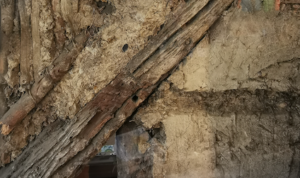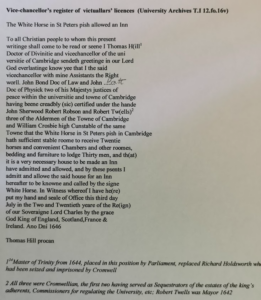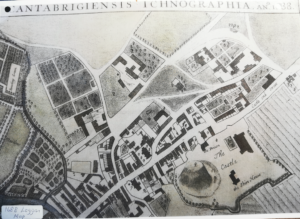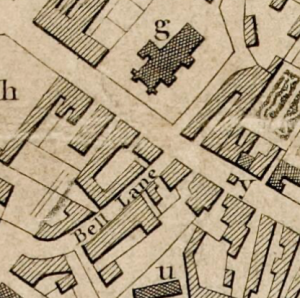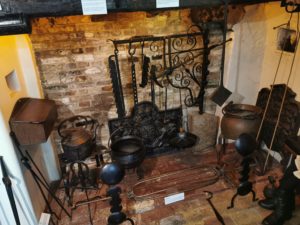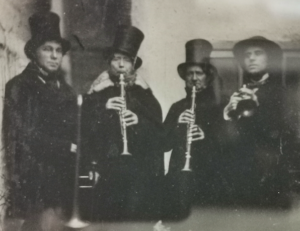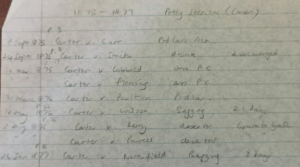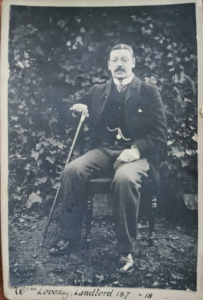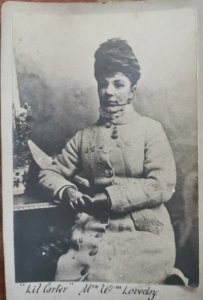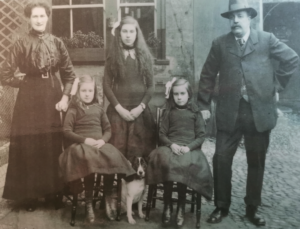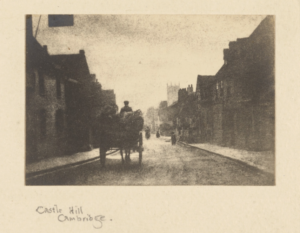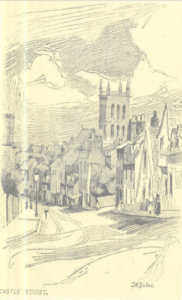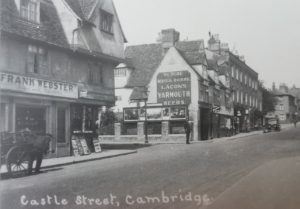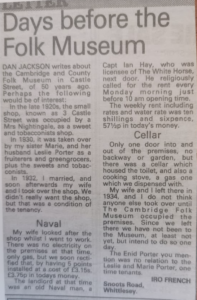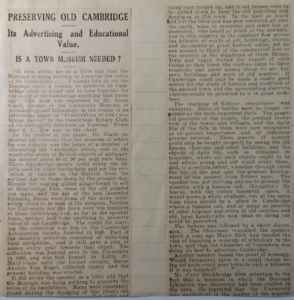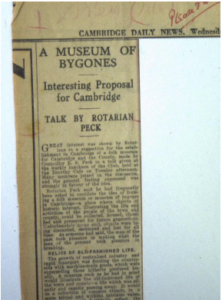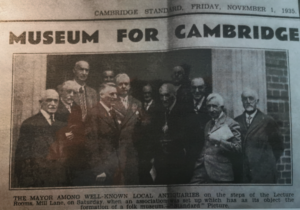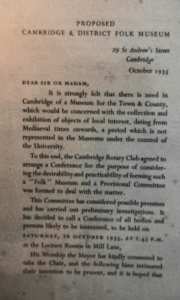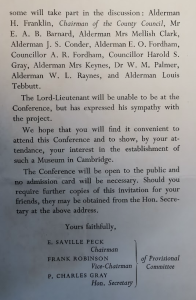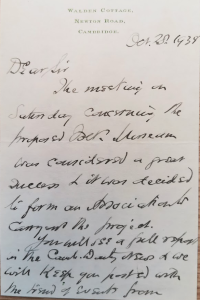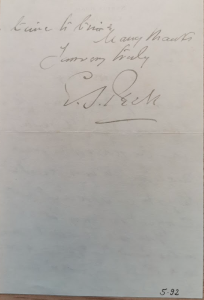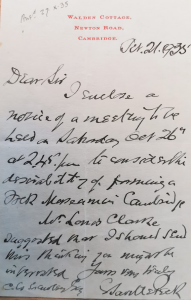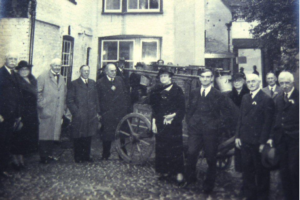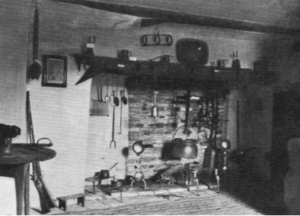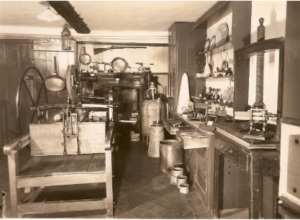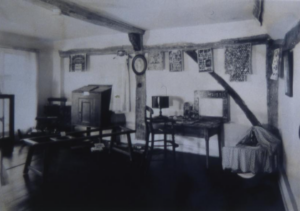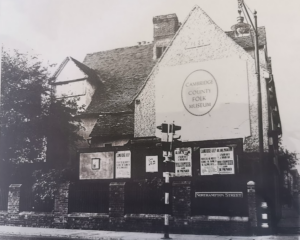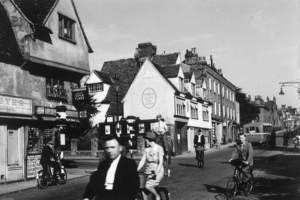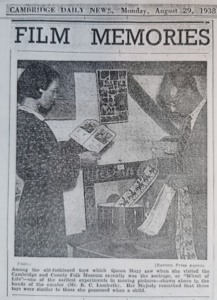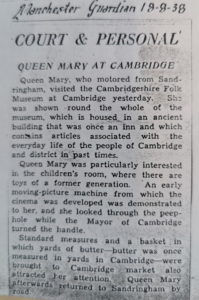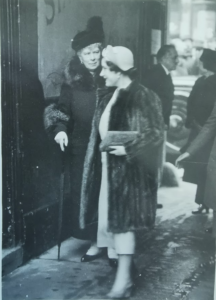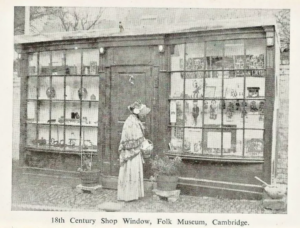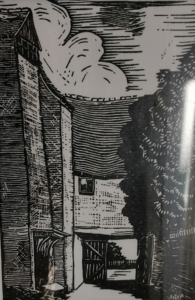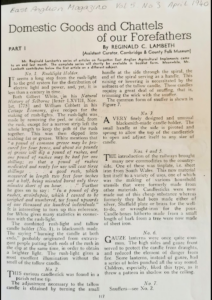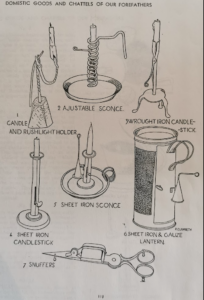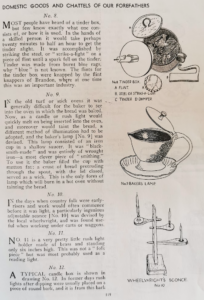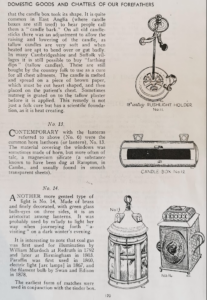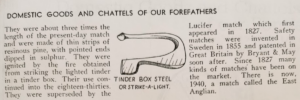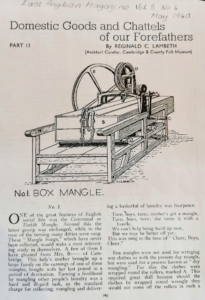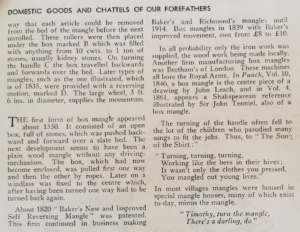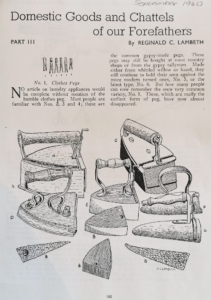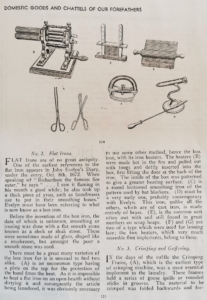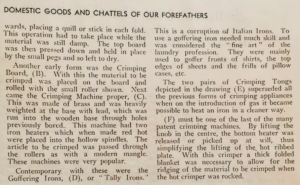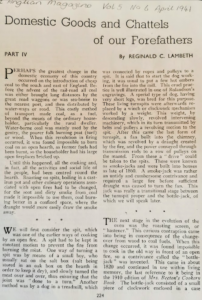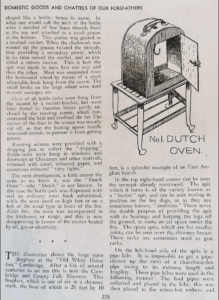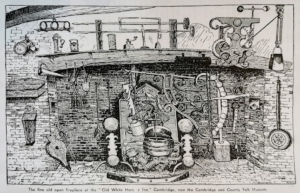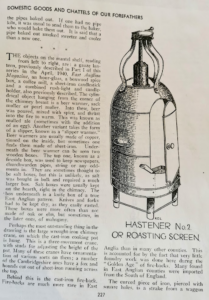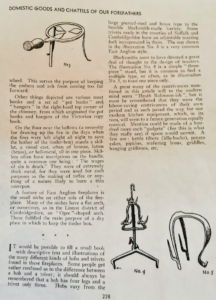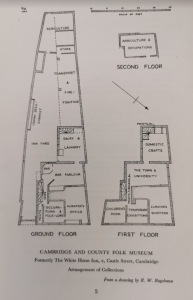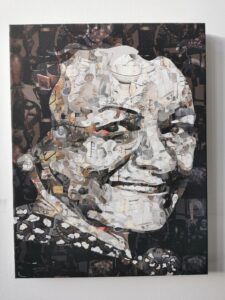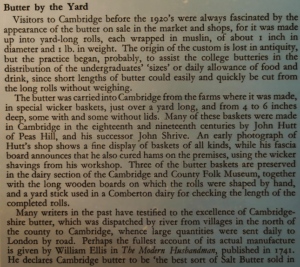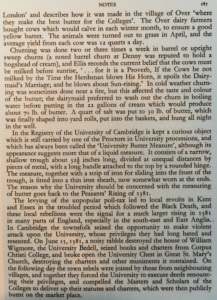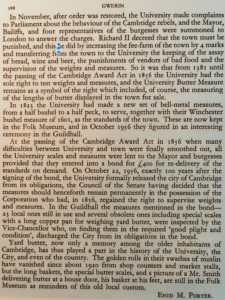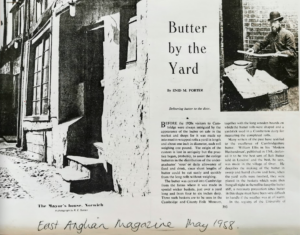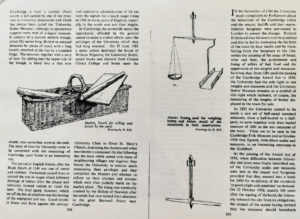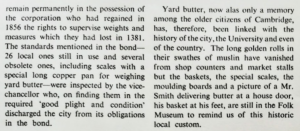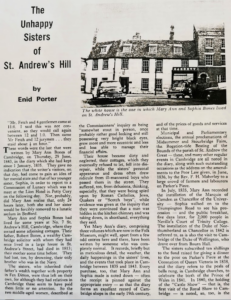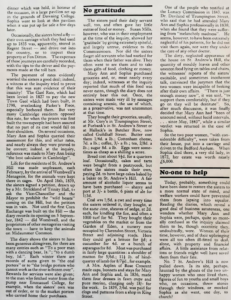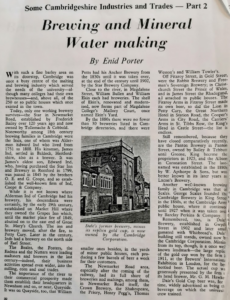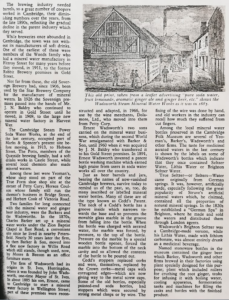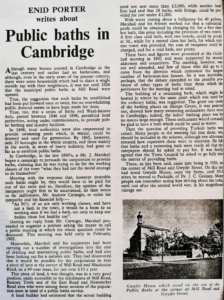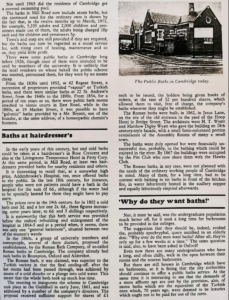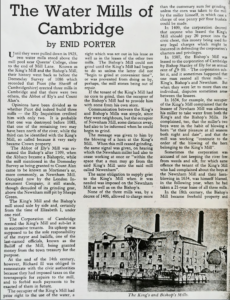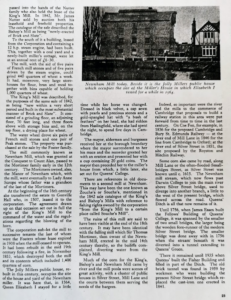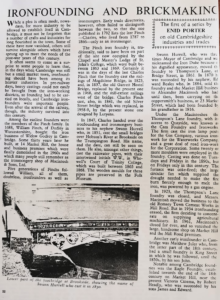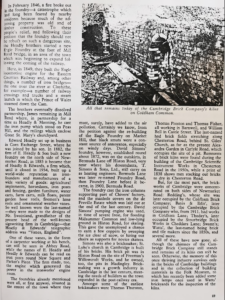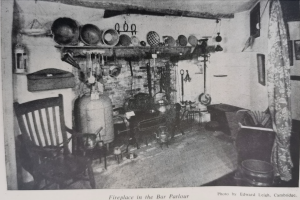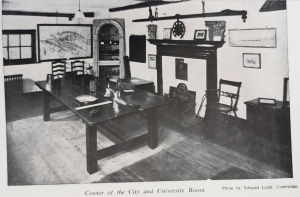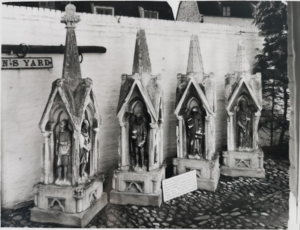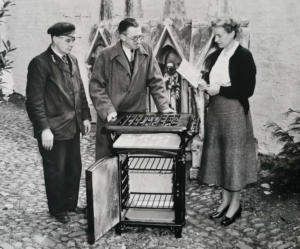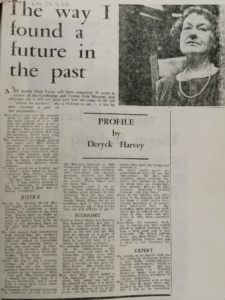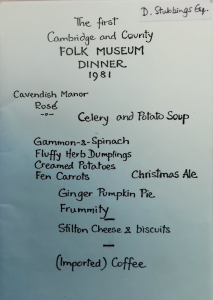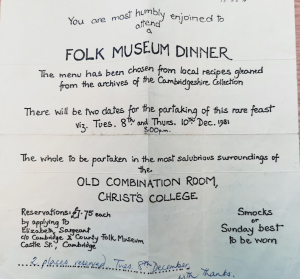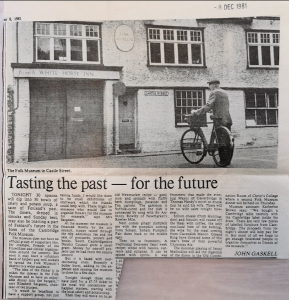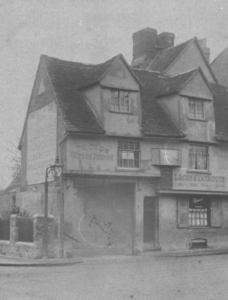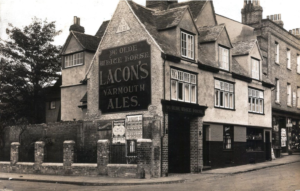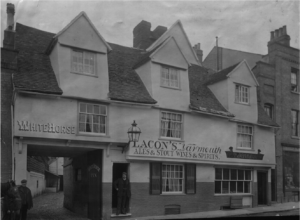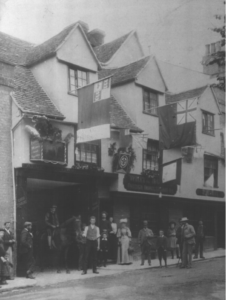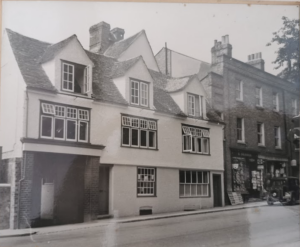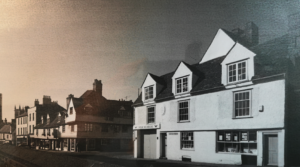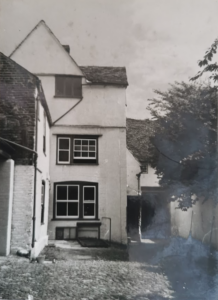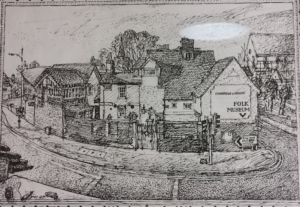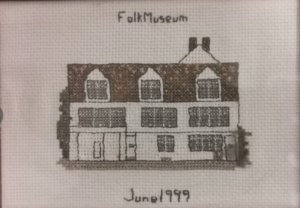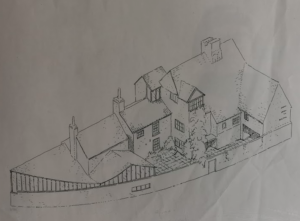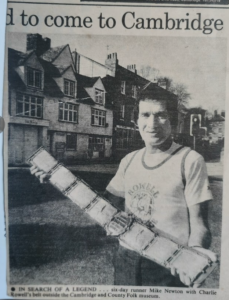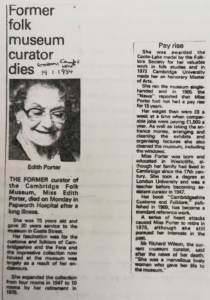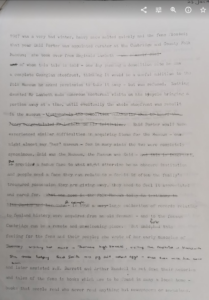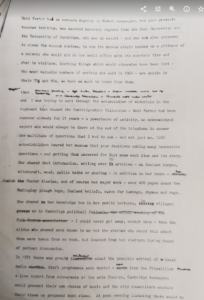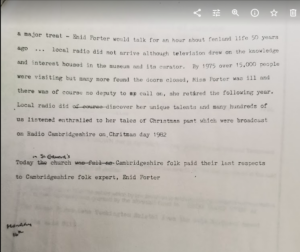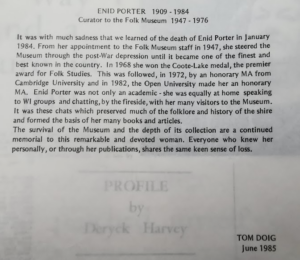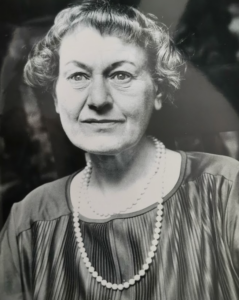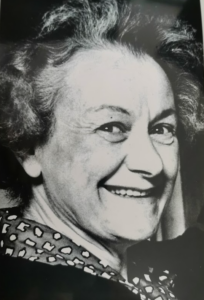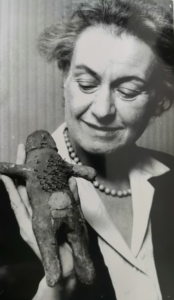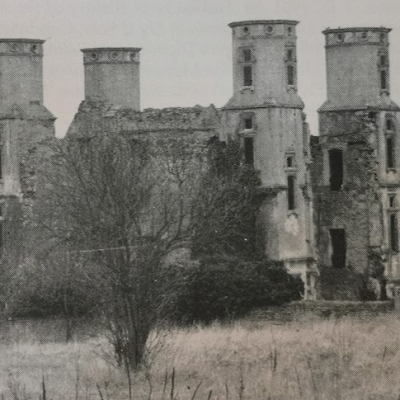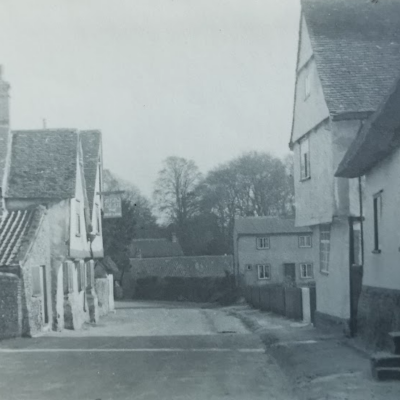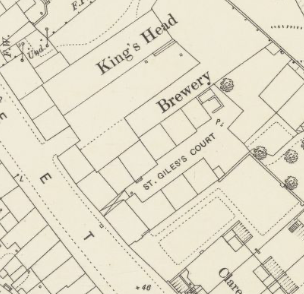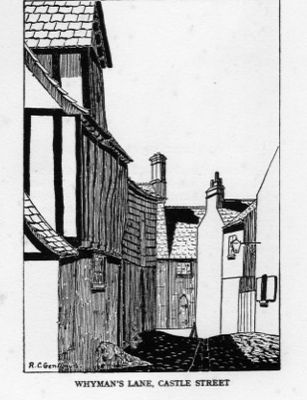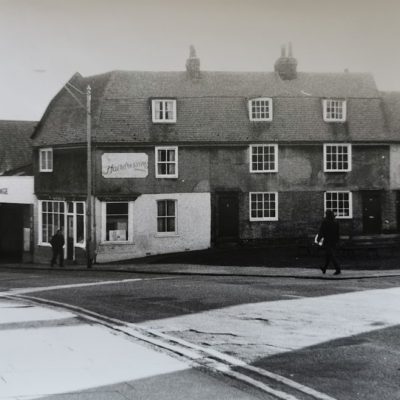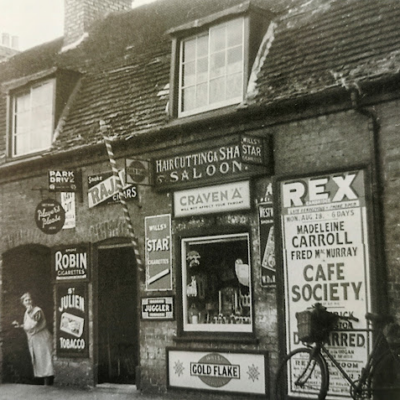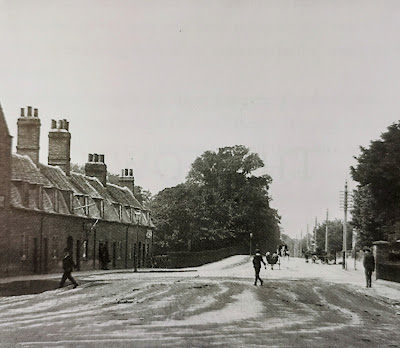Search by topic
- archaeology
- architecture
- bricklayer
- Building of Local Interest
- carpenter
- church
- crime
- dressmaker
- fire
- Great Eastern Railway
- listed building
- medieval
- oral history
- Public House
- Rattee & Kett
- Religious House
- Roman
- scholar
- school
- Then and Now
- tudor
- women
- work
- world war one
- world war two
Search by text
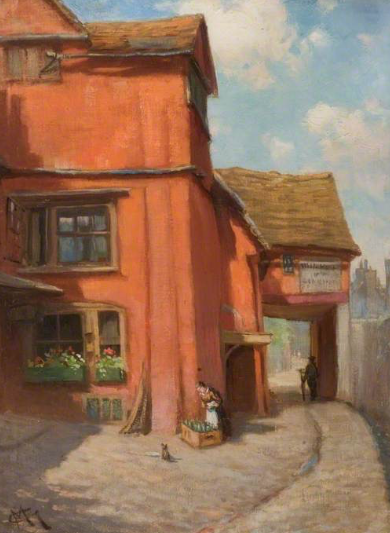 White Horse Inn, by Mary Charlotte Greene (copyright Museum of Cambridge & Cambs Collection)
White Horse Inn, by Mary Charlotte Greene (copyright Museum of Cambridge & Cambs Collection)2 (100) Castle Street, White Horse Inn, Folk Museum, Museum of Cambridge
History of 2 Castle Street
1959 Royal Commission on Historical Monuments Survey of Cambridge: No. 2 Castle Street, formerly the White Horse Inn…of two storeys with cellars and attics, has walls of plastered timber-framing and brick and tile-covered roofs. The range to the street was built in the 16th cent. In the following century a loftier addition, more than doubling the size of the house, was made on the W and to this a W wing was added c. 1700. The most notable feature … is the very large chimney-stack in the SW wall of the original range; the use of pine structural timbers in the 17th cent. work is a feature of some interest and is found in other Cambridge houses. Mainly elm is used in the earlier work…. preserved in the yard is exhibited a shop-front of some elegance removed from no.45 Bridge Street (now destroyed).
The building was originally a farmhouse, probably dating from the 15th century. References to ‘the farmhouse’ describe the building as ‘hardly massive, but just one room deep.’ The area was doubled later in the 17th century when a stable yard was included.
According to a representative of Defined Plasterers who worked on the building in 2023, most of the timber in the oldest part of the building was recycled, much of it from ships, probably dating from the 16th century. Most timbers showed marks of reworking.
1646 licensed as the White Horse Inn
Granted by Thomas Hill, Master of Trinity, who had been given this authority by Parliament after Richard Holdsworth was imprisoned by Cromwell. The inn is described as having enough room for twenty horses and thirty men.
The major portion of the old inn was built in the 17th century. A wing was added around the year 1700 ‘to the west’ and also new windows and various other ‘partitions.’ At one time the inn had an overhanging storey on the street but this was removed early in the 20th century and the front rebuilt with modern windows. It was not a coaching inn nor was it used for carrier cart storage but farmers brought in their carts from outlying villages with livestock etc. and stopped for refreshment at the inn.
The names of the landlords can be traced back to the 1720s from the Register of Licences for the parish of St Peter and other books. The licence had to be returned by the landlord each year. One interesting feature is the swapping over of inns between two landlords.
The White Horse Inn is visible opposite St Gile’s Church which is marked as ‘7’ on the map.
1720-1763 Richard Benstead. He was also rate collector in the parish 1724-5.
1764-1766 Elizabeth Benstead (widow) took over the licence from Richard
1767-1774 John Wallis
1774 John Wallis, White Horse: Thomas Banks, Three Swans
1775
Thomas Banks, White Horse; John Wallis, Three Swans
1775-1790 Thomas Banks
1791 John White. In 1791 he is also the Overseer of the Poor in the parish with Charles Adamson.
1792-1806 Mary White
1798
1807-1818 Joseph Shuker
1819-1841 Elizabeth Shuker (widow)
1834 Simon Cook and Harriett Manning of Stow-cum-Quy married and moved to the White Horse Inn. While there they had two sons, William Manning and Robert. They moved before 1841 and their next child was born in Waterbeach in 1841. Simon and his family emigrated to Sydney in 1850 on the ‘Kate’ and settled in Wollongong where Simon was a farmer until his death in 1868. (from correspondence from family).
In Cambridge Revisited (1921) it is said that the Old White Horse Inn had a hiding hole used by highwaymen in its exceptionally wide central chimney breast.
Workmen in the 1930s also discovered a tiny room with a window and no door at first floor level that could be only entered by scrambling along the edge of the roof from another window. It was speculated that this was some kind of bolt hole, possibly for highwaymen.
1839 18th September – the White Horse in Magdalene Street [almost certainly this location] was used for an inquisition in front of the coroner, Mr Cooper, into the death of Robert Sivill who had hung himself at the premises the previous day. He had been drinking and went to sleep in a loft yard in the afternoon. The verdict was death by temporary insanity produced by drinking. [Inns were often used as venues for such meetings.]
1840 March 31
Marriage of John and Elizabeth carter. John Carter, ostler of St Peter’s parish. Elizabeth Brooks spinster of St Peter’s parish. Fathers, William Carter, labourer; John Brooks, labourer.
1841 unnumbered
John Carter, 35, publican (licence holder 1841-1874)
Elizabeth, 25 [Elizabeth Brooks from Dry Drayton; when they married in 1840 John was an ostler.]
Thomas Bench, 75, hawker
16 Nov: 2 men of 63rd Regiment billeted for 7 days
1842 6 November
Baptism St Giles parish, of Eliza-Ann, daughter of John and Elizabeth carter, publican, The White Horse
1844 7 April 1844
Baptism St Giles parish, of Rosalind Elizabeth, of John and Elizabeth Carter, publican, Castle Street
1848
15 Jan: 2 men of 9th Regiment billeted for 2 days
1850 7 July
Baptism St Giles parish, of Frances Emma, of John and Elizabeth carter, victualler, The White Horse.
1851 unnumbered
John Carter, 45, publican, b Potton Beds
Elizabeth
Eliza Ann
Rosaline Elizabeth
Frances Emma, 10 mos, b Cambridge
Martha Pitt, 18, servant, b Kingston
Ann Carter, sister, 37, b Potton Beds
Edward Burgess, lodger, 52, baker, b Suffolk
Charles Danful, lodger, bricklayer, 33, b Norfolk
James West, 32, lodger, blacksmith, b Norfolk
Uriah Savidge, 30, lodger, cotton weaver, b Norfolk
William Pryce, 22, baker, b Cambs
1852
8 Nov: 2 men of 90th Regiment billeted for 7 days.
1859 There was an auction “of the estates and 50 old licensed inns and public houses” on 22nd June 1859. the White Horse Inn was one of these sold and was described as having ‘a large yard and a ten stall stable.’
1861 (100) White Horse
John Carter, 54, publican, b Beds
Elizabeth, 50, b Dry Drayton
Eliza, 18, b Cambridge
Roseline E, 17, pupil teacher, b Cambridge
William Curtis, lodger, 18, agricultural labourer, b Hunts
John Markham, 18, agricultural labourer, b Hunts
1871 (100)
John Carter, 64, victualler, b Beds
Elizabeth, 59, b Cambs
Anne, 26, b Cambridge
Rosalind, 24, b Cambridge
Henry Miller, 15, b Cambridge
1872 E Lacon and Co. Ltd are owners of the inn
1875-79 Petty Session cases
1881 (100 Castle Street White Horse)
Elizabeth Carter, widow, 64, inn keeper, b Cambridge [John died 10/3/1875. Elizabeth held the licence from 1875-1882. Their daughter Elizabeth held the licence from 1883-1884]
Eliza A, 30, b Cambridge
Elizabeth, 28, b Cambridge
Kettle’s Yard: Susan Haylock, widow, 60, washerwoman, b Cambridge
1891 The White Horse
William Loveday, 39, publican, b Kibworth Leics [William took over the licence in 1884. His father was a builder from Leicester who had come to Cambridge to build the Divinity Schools in St John’s Street, All Saints Church in Jesus Lane and the first part of St Luke’s Church. His father lodged at the White Horse Inn and his son eventually married the landlord’s daughter. William Loveday’s name can be seen in the window glass of the old bar room and Lil’s name is seen on other window glass.]
Rosalind ‘Lil’ Elizabeth [daughter of John and Elizabeth Carter], 38, b Cambridge
Harold, 6, b Cambridge
Mary Gower, 47, servant, b Isleham
William Clark, 17, servant, b Oakington
1898 Charles Henry Robinson took over the licence
1899 Charles Benefield took over the license
1901
Samuel H Chandler, 53, innkeeper, b Bolder Hants [Samuel held the licence from 1900-1901]
Mary L, 15, daughter, b Mansfield Woodhouse Notts
1901
Willoughby Dudley-Hay and his wife started their married life at the inn. Prior to 1901 Willoughby had been a bosun on the Western Telegraph Company cable laying ship ‘Amber’.Their three children were born at the inn. They stayed there for 33 years. When one of the daughters married at St Giles church at 8.30am, a policeman held up the traffic outside so that Willoughby and Sarah could cross the road. They kept pigs and chickens in their yard and according to their grand-daughter, writing in 2010, there was a haunted cupboard on the landing.
1905
1911
Willoughby Dudley-Hay, 50, licensed victualler, b London
Sarah Ann, 39, b Berks
Dorothy, 9, b Cambridge
Winifred, 6, b Cambridge
Irene, 4, b Cambridge
[In 1901 Willoughby Dudley-Hay was a boatswain, married aged 40, living in Limehouse, London]
1913 White Horse
Willoughby Dudley Hay
Headquarters Cambridge Town and County Motor and Cycling Club
1914 the land value of the site was reassessed. Owner was E Lacon & Co Ltd, Albion Breweries, Cambridge
1930
Press Cutting about the public debate for a Cambridge Museum
1933 The museum has its origins in a successful exhibition organised by the Cambridgeshire Federation of Women’s Institutes in October 1933.(Proctor 2010)
1934 Alderman E Saville Peck, chemist, proposed the setting up of a museum devoted to local life in Cambridge. At the time the council had purchased the White Horse Inn with the intention of pulling it down for road widening. Instead, the old inn was hired an used as the premises of the new museum.
Almost exactly a year after the exhibition in Cambridge, Peck gave a talk at a luncheon of the local Rotarians group in October 1934 (see Figure 6). The headline in the local press said ‘Museum of Bygones, An Interesting Proposal for Cambridge’ (Cambridge Daily News 1934) which detailed Peck’s wish that a museum should be set up following the success of the 1933 exhibition. There was a good deal of support among the Rotarians and it was agreed that the group would take the idea further. (Proctor 2010)
1935
A Committee was formed and invitations were distributed for a meeting at the Lecture Rooms in Mill Lane, Cambridge, on Saturday 26th October 1935, to discuss preliminary investigations and possible premises.
(From left to right) Mr E Saville Peck; Sir Sidney Cockerell; Major Fowler; Mr E C Morgan; Mr E A B Barnard; unknown; The Mayor, Cllr R Starr; Dr W M Palmer; Mr H T Wing; Dr F Robinson; Mr J S Conder.
The Cambridge Daily News reported on the meeting, under the heading, ‘Museum of Old Cambridge’ (Cambridge Daily News 1935). Dr Robinson proposed the resolution: “that an association be formed which shall have as its object the establishment in Cambridge of a museum for the exhibition of objects of special local interest dating from medieval times onward.” (Cambridge Daily News 1935) A further resolution was agreed, “That the Association shall be authorised by this conference to hire the premises of the old White Horse Inn, No. 2 Castle-street, for the purposes of the museum.” (Cambridge Daily News 1935) (Proctor 2010)
1936
Cambridge Folk Museum opened. The first curator was R C Lambert. The opening ceremony was hosted by Magdalene College, opposite the new museum, and was led by an address from Sir Cyril Fox, then Director of the National Museum in Wales. The invited guests accompanied Fox as he opened the museum’s entrance gates, saying “I have very great pleasure in declaring the Cambridge and County Folk Museum open.” (Cambridge Daily News 1936) After inspecting the museum, the party returned to the college, where tea was served. (R Proctor The origins of Cambridge & County Folk Museum. 2010)
Key people involved in the establishment of the museum:
The Mayor, Alderman H T Wing (fifth from left); Miss Catherine Parsons, Sir Cyril Fox; Alderman Mrs Keynes; Mr Ernest Saville Peck; unknown man; Dr Frank Robinson.
Ernest Saville Peck 1866-1955, Cambridge pharmacist, he contributed significant collections to the Fitzwilliam Museum.
Dr Frank Robinson (b.1870) was Medical Officer for Heath for Cambridgeshire. He also photographed many aspects of life in Cambridgeshire in the 1920s and 1930s a collection later given to the Folk Museum.
Dr William Mortlock Palmer (b.1866) was a keen local historian and author.
Catherine E Parsons (d.1952) was a local historian and avid collector from the village of Little Abington.
Dr John Saltmarsh (1908-1974) was a Fellow of King;’s College and prominent member of the Cambridge Antiquarian Society.
Mrs Florence Keynes (1861-1958) was acting President until her death.
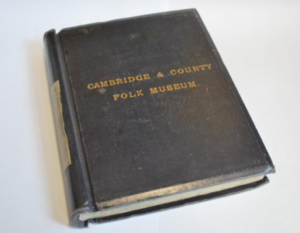
First volume of the accessions register, 1936 to 1937, Cambridge & County Folk Museum.
(Photo R Proctor)
An examination of the donors of the objects in 1936 has been very interesting, revealing that the founders were in fact the main source of acquisitions in the first year of collecting. Of the 909 objects donated in 1936, approximately 506 objects [around 55%] were given by just nine individuals. Of these nine donors, five were the key founders of the museum, and one was Reginald Lambeth, the first resident Custodian and later Assistant Curator. In particular, Miss Parsons donated 143 objects and Dr Palmer donated 127 objects in 1936. (Proctor 2010)
1937
Folk Museum Minutes 1937 – 1941
The most formal declaration of the initial aims of the founders appears in the First Annual Report (Cambridge & County Folk Museum 1937):
“The principal objects of the Association are (a) to collect and preserve for the benefit of the general public and for the purposes of education, objects of local interest and of common use, illustrating the social life of the people of the geographical county of Cambridge from the end of the Middle Ages to the present day, and (b) for these purposes, to secure, equip and maintain, suitable premises.” (Proctor 2010)
1938
Visit by Queen Mary
1930s:
At some point during the 1930s during the demolition of the west side of Bridge Street by St John’s College, the shopfront of 45 Bridge Street was salvaged and given to the Folk Museum. The picture suggests that the shop front was originally a stand-alone exhibit against the wall of the museum yard.
1938
1939
1940
Assistant curator Reginald C Lambeth wrote a series of articles on Domestic Goods:
1941
1942
1943
1944
1945
1946
1947
1947-1977
Enid Porter appointed curator
Enid Porter wrote and published widely on many subjects.
Some Cambridgeshire Trades and Industries
May Day (excerpt from Cambridge Customs and Folklore)
Enid Porter unpublished writings:
Swans and Swan Marks in Fenland
Enid Porter presentation cards
History of Cambridge Railway E Porter notes
Industrial Cambridge notes by Enid Porter
Furniture notes by Enid Porter
The Fens lecture notes by Enid Porter
Round the Market Place, notebook
The Cambridge and County Folk Museum ‘Early Days’ by E Saville Peck
1948
In the 1948 Annual Report it is recorded that the Borough of Cambridge repainted the premises and carried out repairs. The expectation was that the museum would move to Abbey House within the next few years.
1949
1950
1951 The 1951 Brief Guide to the Museum of Cambridge
1952
1953
The figures on the Conduit head are:
Sir John de Cambridge: his daughter was a nun at St Radegunds and he was an MP for the county between 1320 and 1326. His stone house in Findsilver (later Foul, now Trinity Lane) passed to Corpus Christi College, then to Gonville Hall, It was part of Gonville court of Caius College until the mid 18th cent.
Sir John Cheke: born in Petty Cury in 1514. He was the first Regius Professor of Greek as well as Provost of King’s College.
1954
1955
The Davis Gas cooker c.1895 was presented to the Folk Museum by the Eastern Gas Board in May 1955. In the photo are Mr Wosencroft of the company and Enid Porter. Photo by Cambridge Daily News (Neg F8220)
1956
1957
1958
1959
1960
1961
1962 Cambridge and County Folk Museum
Miss E Porter resident curator (at no. 3)
1963
1964
1965
1966
1967
1968
1969
1970
1971
1972
1973
1974
1975
1976
1977
1978
1979
1980
1981
1982
1983
1984
1985
2012
2014
2017
2020
2021
Digging up the stories of Cambridge
PRESS COVERAGE
Contribute
Do you have any information about the people or places in this article? If so, then please let us know using the Contact page or by emailing capturingcambridge@
License
This work is licensed under CC BY-NC-SA 4.0








